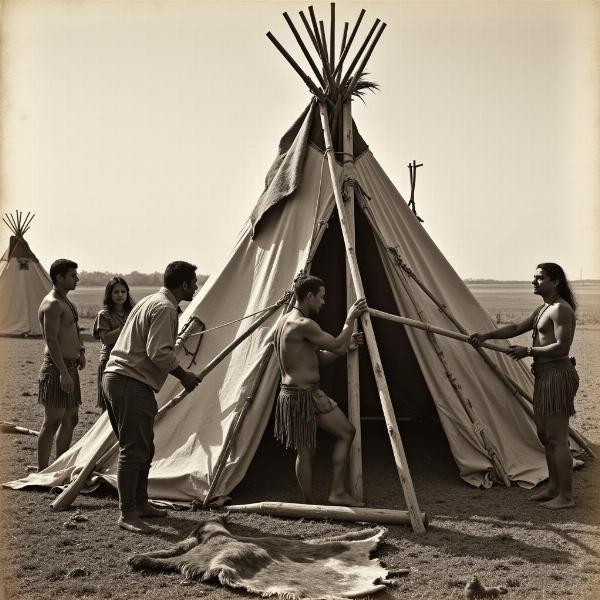Understanding the meaning and cultural significance of a tepee requires delving into the rich history of Native American tribes. The word “tepee” itself comes from the Lakota language, meaning “used to live in.” While often simply translated as “tent” in Hindi (तम्बू – tambu), this basic translation fails to capture the depth of its meaning. So, what is the true “tepee meaning in hindi,” beyond a simple word? It’s about understanding a home, a symbol of nomadic life, and a testament to the ingenuity of the Plains Indians.
Decoding the Tepee: More Than Just a Tent
The tepee is much more than a simple shelter; it’s a carefully engineered structure adapted to the nomadic lifestyle of the Plains tribes. Its conical shape provides excellent wind resistance, while the buffalo hide covering offers protection from the elements. The central smoke hole allows for ventilation and warmth, creating a comfortable living space even in harsh conditions. This sophisticated design reflects a deep understanding of the environment and a resourceful approach to living. Thinking of a tepee solely as a “tambu” diminishes its significance as a culturally rich dwelling.
The Symbolism of the Tepee in Native American Culture
The tepee holds deep symbolic meaning for many Native American tribes. It represents the connection to the earth and the heavens, with the circular base symbolizing the earth and the conical shape pointing towards the sky. The interior often features intricate decorations and paintings, reflecting the tribe’s history, beliefs, and spiritual connection to the land. This makes the tepee not only a physical dwelling but also a spiritual center. Understanding this symbolism is crucial to grasping the true “tepee meaning in hindi.”
Tepee Construction: An Art Form
Building a tepee was a communal activity, passed down through generations. The process involved carefully selecting and preparing wooden poles, meticulously stretching and treating buffalo hides, and skillfully assembling the structure. This traditional craftsmanship reflects the importance of community and the reverence for natural resources. Each step in the construction process held significance, contributing to the overall meaning and purpose of the tepee.
 Tepee Construction by a Native American Tribe
Tepee Construction by a Native American Tribe
Tepee Life: A Glimpse into the Past
Imagine living in a tepee – waking up to the sounds of nature, sharing stories around the central fire, and feeling the connection to your ancestors. Tepee life was a way of life intertwined with the rhythms of nature. Understanding this context adds another layer to the “tepee meaning in hindi.” It wasn’t just a shelter; it was a home, a community center, and a symbol of a unique cultural identity.
What does “Tepee” mean in different Native American languages?
While “tepee” derives from Lakota, other tribes have their own names for this iconic dwelling. Exploring these linguistic variations can further enrich our understanding. For example, the Blackfoot word “niitoyis” and the Cheyenne word “mo’ȯhtávȯse” both refer to similar structures, demonstrating the widespread use of this type of dwelling across the Plains.
Conclusion: The Enduring Legacy of the Tepee
The “tepee meaning in hindi” goes far beyond a simple translation. It encompasses the ingenuity, resourcefulness, and spiritual beliefs of the Native American tribes. It is a symbol of their connection to the land, their communal lifestyle, and their enduring legacy. Understanding the tepee is understanding a vital piece of Native American history and culture.
FAQ:
- What is the primary material used to cover a tepee? Buffalo hide was traditionally the primary material.
- Why is the tepee conical in shape? The conical shape provides excellent wind resistance.
- What is the purpose of the smoke hole in a tepee? The smoke hole allows for ventilation and allows smoke from the fire to escape.
- Is the tepee still used today? While less common, tepees are still used for ceremonial purposes and by some individuals seeking to maintain traditional ways of life.
- How long does it take to build a tepee? The construction time can vary depending on the size and the experience of the builders, but it typically takes several hours to a full day.
- What is the significance of the decorations inside a tepee? The decorations often reflect tribal history, beliefs, and spiritual connection to the land.
- What is the difference between a tepee and a wigwam? A wigwam is a dome-shaped dwelling typically covered with bark, while a tepee is conical and covered with hides.
Meaning-Hindi.in provides high-quality Hindi translation services for businesses, legal documents, technical manuals, websites, educational materials, and more. Our expertise in various fields ensures accurate and culturally sensitive translations. Whether you need document translation or website localization, Meaning-Hindi.in can help. Contact us at [email protected] or call us at +91 11-4502-7584 to discuss your translation needs.